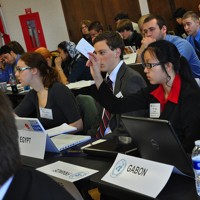Last week, the Patterson School of Diplomacy and International Commerce, where I am an assistant professor, conducted its annual crisis simulation, which has traditionally attempted to put students in critical decision-making situations under conditions of stress, asymmetric information and lack of sleep. This year’s scenario saw Mexican cartel gunmen attacking the Bellagio Casino in Las Vegas, where Brad Pitt, George Clooney and the rest of the cast of “Ocean’s Eleven” had gathered for a reunion. Unfortunately for Pitt and Clooney, there was no Hollywood ending in the Patterson School’s script -- suffice it to say at least Andy Garcia managed to escape from the attack unscathed. While such pyrotechnics may seem out of place so far from the studio lot, the use of simulations to evaluate policy and train policymakers is expanding across the archipelago of institutions dedicated to preparing young people for public service.
War games have played a role in operational and strategic training for a very long time. The purpose of a war game is twofold. On the one hand, it produces data on a proposed course of action, with the quality of data dependent on the expertise of the players and the verisimilitude of the simulation. War gaming may reveal, for instance, that an invasion or offensive makes little sense given the options and resources available to both sides. On the other hand, war gaming provides training in strategic and operational thought under relatively safe and controlled conditions. A war game cannot replace the tension of battle or the responsibility of genuine decision-making, but it can help remedy certain kinds of common errors. Consequently, war games have been part of military training since at least the Napoleonic Wars. In a recent Naval War College Review article, Peter Perla and Ed McGrady argued that the power of war games stem from their association with narrative and storytelling. In a good war game, victory, defeat, gain and loss carry psychological weight that gives the players a stake in outcomes and makes their decision-making more realistic.
What goes for war goes for policy other than war. Public and foreign policy programs have increasingly used simulations as training and teaching tools. Policy initiatives, whether foreign or domestic, generate strategic dynamics; players respond to how other players have changed the game environment. Consequently, playing games can help students develop expertise regarding how to manage strategic dynamics, as well as more specific skills such as crisis negotiation.

